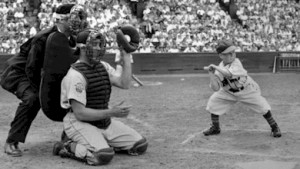I just finished reading the excellent book “Bill Veeck: Baseball’s Greatest Maverick” by Paul Dickson (an excellent read by the way; you’ll have a completely different viewpoint on Veeck, the integration of baseball in the last 1940s and the modern in-game experience after reading this book), and was thinking of the infamous Veeck stunt of putting in Eddie Gaedel as the lead-off hitter of a game in 1951.
At the time, the commissioner Happy Chandler and the AL league president immediately voided his contract and banned Gaedel as being a “mockery of the game.” But after reading Veeck’s book, which details a near constant state of aggravation between himself and whoever was in charge of baseball at the time, its hard to determine whether this reaction was more about Gaedel or whether it was about an institutional hatred of Veeck.
However, consider this: today’s OBP-crazed baseball world, would a revisiting of someone like Gaedel be a worthwhile endeavor for a team? Imagine having a player who could lead off every game and nearly guarantee a walk every time? A runner on first with nobody out has a run-expectancy (RE) of about .826 (using 2013 numbers). The RE of a typical lead-off hitter with a .400 OBP should be about 40% of the difference between the RE of nobody-on, nobody out (.467) and nobody-on, one out (.248), or about .336. The RE difference? .826-.336 = .490. That’s nearly a half a run, per game! Maybe in practice it’d be slightly less than .490 , since your under-sized lead-off hitter may end up making an out here and there … but it wouldn’t drop that much considering how difficult it’d be to *really* throw three strikes into a strike-zone not much larger than the baseball itself.
What manager wouldn’t take nearly an additional half a run expectancy per game? That’s an awful lot of run expectancy for teams that generally average somewhere between 3.1 and 5.2 runs per game (those were the highest and lowest scoring teams in 2013 on a per-game basis). If the Nationals had half a run more per game last year, they would have had a pythagorean (expected) W/L record of 93-69, an improvement of 9 wins over their expected W/L record. Not insignificant.
Another huge difference in the game today versus 1951; a much more “understanding” American culture when it comes to discrimination of any type. How can anyone justify banning someone based on their having dwarfism or some other size-limiting disability? That’d never fly in a court of law. This topic was discussed on a sports law blog I found a few years back and the author points out some very obvious points; would the voiding of the Gaedel contract have been possible in today’s legal environment considering the Americans with Disabilities Act?
Your Eddie Gaedel hitter bats leadoff every game, walks, then is immediately replaced by whoever would have normally been your lead-off hitter. And because of this simple act, you’re likely to score about a half a run more per game.
How could anyone claim it was a mockery of the game if you demonstrated how much this move helps you win?
An interesting thought. Perhaps this is the next Billy Beane market inefficiency to exploit.

DH him, and he could walk 4-5x a game. Of course his baserunningmay be a problem.
John C.
18 Apr 14 at 11:29 pm
There were two notable leadoff hitters who come to mind who hit in exaggerated crouches: Rickey Henderson and Pete Rose. I assume there was some protest at times about their shrunken strike zones. Pete got more hits, but Rickey drew significantly more walks, 624 more in 2,544 fewer plate appearances. Henderson was second all time in walks, behind Bonds. Rickey was also the career leader in runs scored.
KW
19 Apr 14 at 8:37 pm
Its amazing to remember Rickey’s crouch and then consider the fact that he hit for power out of it… I certainly remember people complianing about his batting stance in particular.
Todd Boss
21 Apr 14 at 11:16 am